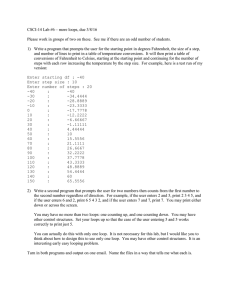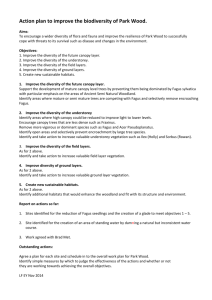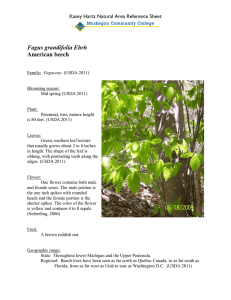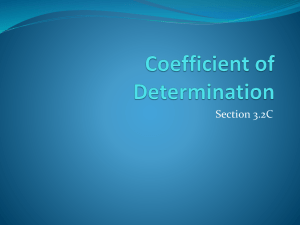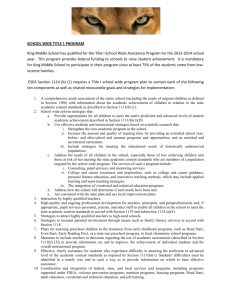STUDYING THE POSSIBILITY OF THE USE OF LANDSAT SATELLITE IMAGERY... Fagus orientalis OF IRAN
advertisement
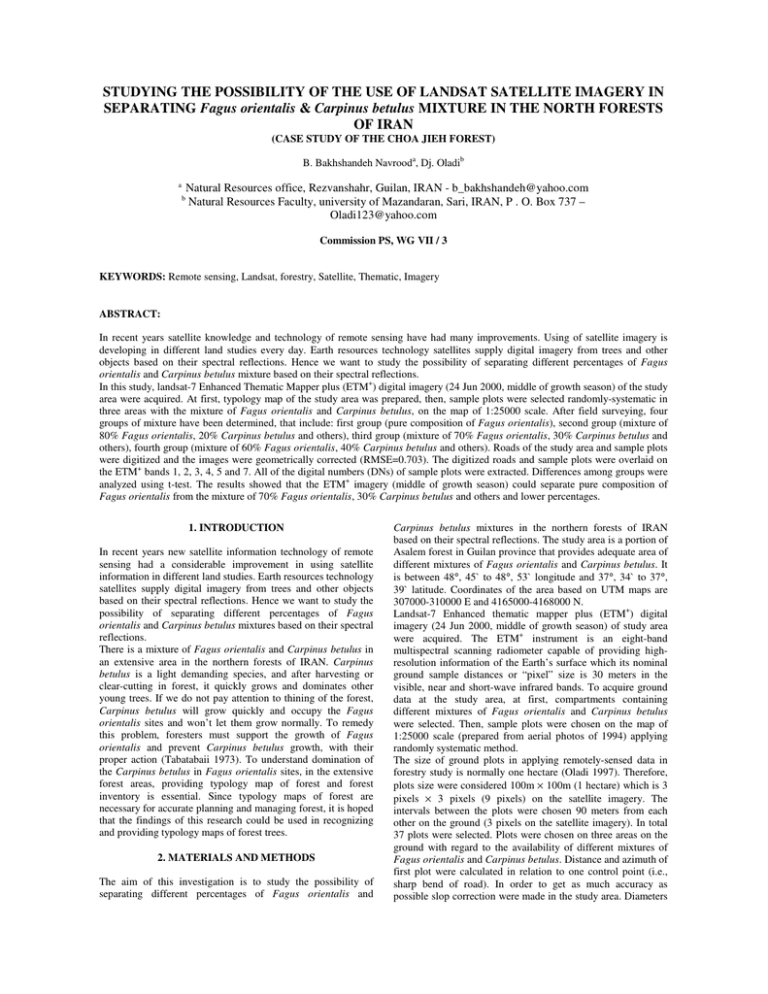
STUDYING THE POSSIBILITY OF THE USE OF LANDSAT SATELLITE IMAGERY IN SEPARATING Fagus orientalis & Carpinus betulus MIXTURE IN THE NORTH FORESTS OF IRAN (CASE STUDY OF THE CHOA JIEH FOREST) B. Bakhshandeh Navrooda, Dj. Oladib a b Natural Resources office, Rezvanshahr, Guilan, IRAN - b_bakhshandeh@yahoo.com Natural Resources Faculty, university of Mazandaran, Sari, IRAN, P . O. Box 737 – Oladi123@yahoo.com Commission PS, WG VII / 3 KEYWORDS: Remote sensing, Landsat, forestry, Satellite, Thematic, Imagery ABSTRACT: In recent years satellite knowledge and technology of remote sensing have had many improvements. Using of satellite imagery is developing in different land studies every day. Earth resources technology satellites supply digital imagery from trees and other objects based on their spectral reflections. Hence we want to study the possibility of separating different percentages of Fagus orientalis and Carpinus betulus mixture based on their spectral reflections. In this study, landsat-7 Enhanced Thematic Mapper plus (ETM+) digital imagery (24 Jun 2000, middle of growth season) of the study area were acquired. At first, typology map of the study area was prepared, then, sample plots were selected randomly-systematic in three areas with the mixture of Fagus orientalis and Carpinus betulus, on the map of 1:25000 scale. After field surveying, four groups of mixture have been determined, that include: first group (pure composition of Fagus orientalis), second group (mixture of 80% Fagus orientalis, 20% Carpinus betulus and others), third group (mixture of 70% Fagus orientalis, 30% Carpinus betulus and others), fourth group (mixture of 60% Fagus orientalis, 40% Carpinus betulus and others). Roads of the study area and sample plots were digitized and the images were geometrically corrected (RMSE=0.703). The digitized roads and sample plots were overlaid on the ETM+ bands 1, 2, 3, 4, 5 and 7. All of the digital numbers (DNs) of sample plots were extracted. Differences among groups were analyzed using t-test. The results showed that the ETM+ imagery (middle of growth season) could separate pure composition of Fagus orientalis from the mixture of 70% Fagus orientalis, 30% Carpinus betulus and others and lower percentages. 1. INTRODUCTION In recent years new satellite information technology of remote sensing had a considerable improvement in using satellite information in different land studies. Earth resources technology satellites supply digital imagery from trees and other objects based on their spectral reflections. Hence we want to study the possibility of separating different percentages of Fagus orientalis and Carpinus betulus mixtures based on their spectral reflections. There is a mixture of Fagus orientalis and Carpinus betulus in an extensive area in the northern forests of IRAN. Carpinus betulus is a light demanding species, and after harvesting or clear-cutting in forest, it quickly grows and dominates other young trees. If we do not pay attention to thining of the forest, Carpinus betulus will grow quickly and occupy the Fagus orientalis sites and won’t let them grow normally. To remedy this problem, foresters must support the growth of Fagus orientalis and prevent Carpinus betulus growth, with their proper action (Tabatabaii 1973). To understand domination of the Carpinus betulus in Fagus orientalis sites, in the extensive forest areas, providing typology map of forest and forest inventory is essential. Since typology maps of forest are necessary for accurate planning and managing forest, it is hoped that the findings of this research could be used in recognizing and providing typology maps of forest trees. 2. MATERIALS AND METHODS The aim of this investigation is to study the possibility of separating different percentages of Fagus orientalis and Carpinus betulus mixtures in the northern forests of IRAN based on their spectral reflections. The study area is a portion of Asalem forest in Guilan province that provides adequate area of different mixtures of Fagus orientalis and Carpinus betulus. It is between 48°, 45` to 48°, 53` longitude and 37°, 34` to 37°, 39` latitude. Coordinates of the area based on UTM maps are 307000-310000 E and 4165000-4168000 N. Landsat-7 Enhanced thematic mapper plus (ETM+) digital imagery (24 Jun 2000, middle of growth season) of study area were acquired. The ETM+ instrument is an eight-band multispectral scanning radiometer capable of providing highresolution information of the Earth’s surface which its nominal ground sample distances or “pixel” size is 30 meters in the visible, near and short-wave infrared bands. To acquire ground data at the study area, at first, compartments containing different mixtures of Fagus orientalis and Carpinus betulus were selected. Then, sample plots were chosen on the map of 1:25000 scale (prepared from aerial photos of 1994) applying randomly systematic method. The size of ground plots in applying remotely-sensed data in forestry study is normally one hectare (Oladi 1997). Therefore, plots size were considered 100m × 100m (1 hectare) which is 3 pixels × 3 pixels (9 pixels) on the satellite imagery. The intervals between the plots were chosen 90 meters from each other on the ground (3 pixels on the satellite imagery). In total 37 plots were selected. Plots were chosen on three areas on the ground with regard to the availability of different mixtures of Fagus orientalis and Carpinus betulus. Distance and azimuth of first plot were calculated in relation to one control point (i.e., sharp bend of road). In order to get as much accuracy as possible slop correction were made in the study area. Diameters at breast height (d.b.h) and canopy closure of the trees were measured in each plot. Thereafter, percentages of different mixture of the all tree types, in the plots, were calculated and classified in four groups. It is worthwhile to mention that after obtaining ground data and measuring different mixtures percentages, 9 plots were excluded from total of plots due to crown closure of less than 60% or domination of other species than Fagus orientalis and Carpinus betulus. Four groups of mixtures have been obtained encompassing: I) pure composition of Fagus orientalis, II) 80% Fagus orientalis, 20% Carpinus betulus and others, III) 70% Fagus orientalis, 30% Carpinus betulus and others, and IV) 60% Fagus orientalis, 40% Carpinus betulus and others. Each group includes 7 plots and in total 28 plots were selected. The ETM+ imagery was geometrically corrected using 1:25000 maps with RMSE = 0.703. Roads of the study area and sample plots were digitized. The digitized roads and sample plots were overlaid on the ETM+ bands 1, 2, 3, 4, 5 and 7. Then, all of the digital numbers (DNs) of sample plots were extracted (figure 1). 3. RESULTS After extracting the DNs of the plots, average of their DNs were calculated for all bands (except band 6, table 1). From table 1, it is obvious that there is disorder among the means of plots in bands, 1, 2, 3 and 4. Therefore, they cannot be separated. This is due to the narrow dynamic range of DNs in bands 1,2, and 3.This narrow range of DNs reflects plants′ efficient absorption of the ultra-violate and the visible region of the spectrum for the energy required for photosynthesis. Chlorophyll absorbs approximately 80 to 90% of the incident energy in the visible part of the spectrum (0.4 to 0.7 µm, band 1, 2 and 3). Although band 4 represented a wider DNs range than bands 1, 2, and 3, this band showed lower sensitivity to different mixture of Fagus orientalis and Carpinus betulus than bands 1, 2, and 3. Result of this study is similar to the finding of other researchers (Spanner et al. 1990 and Oladi 1997). Table 1, revealed that there is differences among all groups in band 5, except between third and fourth groups. Result of band7 Figure 1. Image of ETM+ bands 5 with roads and digitized sample plots Fourth group Third group Second group First group Number of groups Number plots − x (Average of DNs) of b1 b2 b3 b4 b5 b6 12 24 72.7778 71.4444 58.0000 57.4444 44.7778 43.7778 117.8889 121.1111 101.6667 103.1111 48.6667 48.3333 25 27 28 72.1111 73.0000 72.3333 57.4444 56.6667 56.2222 44.4444 43.3333 42.2222 124.4444 122.0000 122.0000 100.1111 101.3333 94.7778 45.7778 46.6667 43.1111 32 33 72.5556 73.6667 55.3333 56.2222 42.6667 42.6667 118.6667 125.4444 92.3333 97.7778 42.1111 43.2222 3 7 13 73.3333 72.6667 72.2222 59.7778 59.8889 59.8889 45.3333 45.4444 46.3333 131.8889 126.7778 116.3333 107.1111 106.7778 105.1111 49.1111 50.7778 51.6667 17 21 22 72.2222 73.1111 72.1111 59.7778 57.7778 56.7778 43.8889 44.6667 43.0000 123.5556 125.3333 118.5556 106.7778 105.6667 106.4444 50.7778 48.5556 46.1111 23 73.3333 57.8889 42.4444 122.2222 104.1111 47.2222 4 5 8 10 74.2222 73.1111 74.2222 73.8889 61.5556 60.2222 61.5556 60.3333 46.2222 44.0000 46.1111 44.7778 133.8889 124.4444 134.8889 132.4444 112.6667 108.7778 112.0000 114.1111 51.7778 50.4444 51.5556 53.6667 19 20 29 72.1111 72.3333 74.3333 59.5556 59.8889 61.0000 45.2222 45.7778 40.8889 123.3333 123.1111 135.3333 109.4444 107.5556 111.8889 52.4444 50.0000 51.0000 1 9 74.4444 74.2222 62.1111 61.2222 45.8889 47.1111 133.6667 129.5556 113.4444 109.0000 51.5556 50.3333 14 16 18 74.1111 72.2222 72.6667 58.8889 59.7778 60.8889 45.0000 43.7778 45.1111 132.7778 123.5556 130.1111 110.8889 107.8889 113.1111 50.7778 50.3333 53.4444 26 30 73.7778 75.0000 61.5556 61.5556 45.7778 47.4444 137.0000 133.7778 114.1111 111.7778 51.7778 50.2222 Table 1. Average of DNs in relation to ETM+ data of 24 Jun 2000. analyses showed that there is difference between first group with third and fourth groups. This band, also, revealed that there is interference among all other groups. Moreover, average DNs increases in band 5 and 7 from group 1 to 4, especially in band 5. Therefore, the minimum DNs are related to the first group and the maximum DNs are related to the third and fourth groups. The reason for minimum DNs of first group than other groups is due to different spectral reflectance of Fagus orientalis and Carpinus betulus tree leaves. Based on empirical experience of experts, leaves of Fagus orientalis and Carpinus betulus trees of study area in accordance to date of imagery acquisition (July), color of Fagus orientalis leaves is darker than that of Carpinus betulus trees. Canopy crown of Fagus orientalis seems much darker than Carpinus betulus canopy crowns; therefore, spectral reflectance of Fagus orientalis is less than that of Carpinus betulus. To compare the averages of four different mixture groups in band 5 and 7, statistical analyses were applied using T-test. 4. CONCLUSION Statistical analyses of this study showed that in band 5, there is a significant difference at level 95 and 99% probability between means of third group (mixture of 70% Fagus orientalis, 30% Carpinus betulus and others) with first group (pure composition of Fagus orientalis) and between means of fourth group (mixture of 60% Fagus orientalis, 40% Carpinus betulus and others) with first group, but in other comparisons between means in bands 5 and 7, some of comparisons are not significant and some of them are significant. Therefore, it shows the ability of band 5 in separating different mixtures of all aforementioned groups. It means that ETM+ band 5 is able to separate pure composition of Fagus orientalis from: i) mixture of 70% Fagus orientalis, 30% Carpinus betulus and others ii) mixture of 60% Fagus orientalis, 40% Carpinus betulus and others in middle of growth season, however, it is not able to completely separate pure composition of Fagus orientalis from the mixture of 80% Fagus orientalis, 20% Carpinus betulus and others and other groups from each other. Result of ETM+ band 7 analyses showed that this band is not able to significantly separate all means different groups. It proves that the ability of separating different mixtures in this band is lower than band 5. Many studies have shown that Landsat satellite data has relatively good ability in separating and inventorying of different forest species. Oladi (1988) used Landsat Multi Spectral Scanner (MSS) to separate pure forests of two species of Beech and Oak with 80% accuracy from each other. Poso et al. (1987) could provide a method of forest inventory for pine and broad leaves trees using Landsat-MSS and TM imagery. According to a study of Baker (1992) Landsat-TM imagery is able to provide very good information about invading plants into the plantations. Result of this study shows a relatively good ability of Landsat- ETM+ imagery in separating mixture of two species of Fagus orientalis and Carpinus betulus from each other. REFERENCES Baker, B., 1992. Integration of Land sat TM data and Airborne Radar data into an operational GIS for forest inventory application. 15th Can symposium on Remote Sensing: 1992, 14 July, Torento, Ont., Canada. Oladi, Dj., 1988. Studying the spectral reflection of tress (Beech and Oak species) with use of satellite data. M.S. thesis, Trbiat-emoddarres University, IRAN. Oladi, Dj., 1997. Developing a framework and methodology for plantation assessment using Remotely Sensed data. Ph.D. thesis, university of New Brunswick, Canada. Poso, s., pananen, R. and simila, M., 1987. Forest inventory by compartment using satellite imagery. Siva Fennec, 21(1):69-94. Spanner, M.A., Piecer, L.L., peterson,D.L. and Runinng, S.W.1990. Remote sensing of temperate coniferous forest leaf are a index. The influence of canopy closure under story vegetation and background reflection. Int.J. Remotely-Sensed data. Ph.D. thesis, university of New Brunswick, Canada. Tabatabaii, R., 1973. Dendrology course lecture. Mazandaran University, IRAN.
